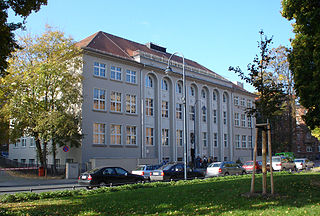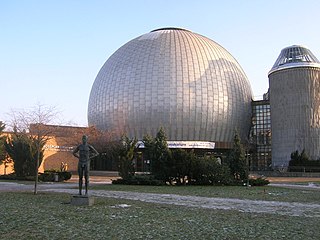 W
WThe Archenhold Observatory was named in honour of Friedrich Simon Archenhold, is an observatory in Berlin-Treptow. It houses the Großer Refraktor, which is the longest pointable telescope in the world. It is also called the Himmelskanone.
 W
WThe Arithmeum is a mathematics museum owned by the Forschungsinstitut für Diskrete Mathematik at the University of Bonn.
 W
WThe Technik Museum Sinsheim is a technology museum in Sinsheim, Germany. Opened in 1981, it is run by a registered association called "Auto & Technik Museum Sinsheim e. V." which also runs the nearby Technik Museum Speyer.
 W
WThe Botanical Museum Greifswald is a scientific collection at the department of botany of the University of Greifswald. It was founded around 1850 by Julius Münter and is the largest botanical collection in the state of Mecklenburg-Vorpommern.
 W
WThe Deutsches Museum in Munich, Germany, is the world's largest museum of science and technology, with about 28,000 exhibited objects from 50 fields of science and technology. It receives about 1.5 million visitors per year.
 W
WThe Deutsches Museum Bonn is a museum with exhibits and experiments of famous scientists, engineers and inventors. Its central themes are research and technology in Germany after 1945.
 W
WDeutsches Technikmuseum Berlin in Berlin, Germany is a museum of science and technology, and exhibits a large collection of historical technical artifacts. The museum's main emphasis originally was on rail transport, but today it also features exhibits of various sorts of industrial technology. In 2003, it opened both maritime and aviation exhibition halls in a newly built extension. The museum also contains a science center called Spectrum.
 W
WThe German Space Travel Exhibition is a permanent exhibition in the village Morgenröthe-Rautenkranz, Germany. The exhibition is dedicated to Spaceflight and Space exploration.
 W
WHamburg Observatory is an astronomical observatory located in the Bergedorf borough of the city of Hamburg in northern Germany. It is owned and operated by the University of Hamburg, Germany since 1968, although it was founded in 1825 by the City of Hamburg and moved to its present location in 1912. It has operated telescopes at Bergedorf, at two previous locations in Hamburg, at other observatories around the world, and it has also supported space missions.
 W
WHamburg Planetarium is one of the world's oldest, and one of Europe's most visited planetariums. It is located in the district of Winterhude, Hamburg, Germany, and housed in a former water tower at the center of Hamburg Stadtpark.
 W
WThe Hermann Oberth Space Travel Museum is a museum of space technology in the Franconian city of Feucht in Bavaria, Germany.
 W
WThe Rheinisches Industriemuseum is a decentralized museum with six locations in Rhineland, western Germany. The locations are:Oberhausen: the main site at the old Zinkfabrik Altenberg, near the Oberhausen main station Ratingen: Textilfabrik Cromford, the first factory in continental Europe, named after the Cromford Mill Solingen: Gesenkschmiede Hendrichs (forge) Bergisch Gladbach: Papiermühle Alte Dombach Engelskirchen: Ermen & Engels cotton spinning mill Euskirchen: Tuchfabrik Müller
 W
WThe Mathematikum is a science museum, located in Gießen, Germany, which offers a huge variety of mathematical hands-on exhibits. It was founded by Albrecht Beutelspacher, a German mathematician.
 W
WMiMa is a museum of mineralogy and mathematics in Oberwolfach, in the central Black Forest in southern Germany. The museum was opened on 30 January 2010 on the site of the mineral museum after a two-year conversion and expansion phase. It is operated jointly by the municipality of Oberwolfach, the Oberwolfach Society of the Friends of Minerals and Mining and the Mathematics Research Institute, Oberwolfach.
 W
WThe Mueller Cloth Mill, located in Euskirchen, North Rhine-Westphalia, Germany is a section of the LVR Museum of Industry. The museum provides insight into the production process of a cloth mill by showing fully working machinery and equipment from around 1900. Opened in 2000, the museum preserves the mill's state at its shutdown in 1961. LVR Industrial Museum Mueller Cloth Mill is an ‘Anchor Point’ of the European Route of Industrial Heritage and a central stop on the ‘Wool Route’.
 W
WThe Deutsches Optisches Museum Jena is a science and technology museum displaying optical instruments from eight centuries. It gives a technical and cultural-historical survey of the development of optical instruments. The development of the city Jena to the centre of the optical industries since the mid-19th-century is integrated in the exhibition, connected with the lifeworks of Ernst Abbe, Carl Zeiss and Otto Schott.
 W
WThe Otto Lilienthal Museum in Anklam (Germany) is a museum dedicated to the "glider king" Otto Lilienthal, the flight pioneer, as well as a pioneer in technical, social and cultural projects. Lilienthal made over 2,000 flights in gliders of his design starting in 1891 with his first glider version, the Derwitzer, until his death in a gliding crash in 1896. His total flying time was five hours.
 W
WOzeaneum is a public aquarium in the German city of Stralsund. It is a main attraction of the German Oceanographic Museum, arguably one of the three largest institutions of its kind in Europe.
 W
WThe Phæno Science Center is an interactive science center in Wolfsburg, Germany, completed in 2005.
 W
WThe Technik Museum Speyer is a technology museum in Speyer (Rhineland-Palatinate), Germany.
 W
WThe Technoseum is a technology museum in Mannheim, Baden-Württemberg, Germany, with displays covering the industrialisation of the south-western regions of the country.
 W
WThe Universum Bremen is a science museum in Bremen, Germany. Visitors are encouraged to interact with most of the approximately 250 exhibits. It receives on average 450,000 visitors annually.
 W
WThe Völklingen Ironworks is located in the German town of Völklingen, Saarland. In 1994, it was declared by UNESCO as a World Heritage Site.
 W
WThe Zeiss Major Planetarium is a planetarium in Berlin and one of the largest modern stellar theatres in Europe. It was opened in 1987 on the borders of the Ernst-Thälmann-Park housing estates in the Prenzlauer Berg locality of Berlin.
 W
WThe Zoological Collection Rostock is a scientific university collection and associated with the zoological department of the University of Rostock, Germany. The collection was founded in 1775 by Oluf Gerhard Tychsen and is used both for teaching and research. Parts of the collection are open to the public.